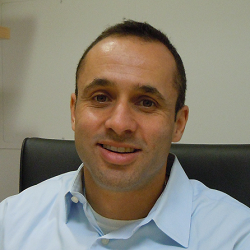How Epilepsy Surgery Helps People with Brain Tumors
, by Brittany Cordeiro, NCI-CONNECT Program Manager
Neurosurgeon Dr. Kareem Zaghloul is helping people with brain tumors by performing surgery that removes their tumor and the cause of their seizures.
Seizures are one of the most common symptoms and signs of a brain tumor—particularly for people who do not have a history of seizures. Seizures can be debilitating and impact a person’s quality of life.
Neurosurgeon Kareem Zaghloul, M.D., Ph.D., of the National Institute of Neurological Disorders and Strokes (NINDS) at NIH is performing surgeries that can eliminate seizures and improve a person’s health and well-being.
“We surgically remove the brain tumor and the area that is causing seizures,” Dr. Zaghloul explains. In some patients, the process involves two surgeries and an extended hospital stay for monitoring. The two-stage surgery has shown to be effective for the subset of patients treated. Dr. Zaghloul is also studying the extracted tissue thought to be the cause of the seizures. His team has found metabolic differences in this tissue compared to normal brain tissue.
He received his medical degree and postdoctoral degree from the University of Pennsylvania in 2003, after graduating from the Massachusetts Institute of Technology. Dr. Zaghloul completed a neurological surgery residency in 2010 at the University of Pennsylvania. During this time, he completed postdoctoral research investigating the neural correlates of human memory encoding, decision making, and reward. Dr. Zaghloul also completed clinical fellowships in epilepsy surgery and in debulking surgery (removing as much of a tumor as possible). He joined NINDS in 2010.
“Seizures have a profound impact on people, and because we already perform surgery for people with epilepsy, we thought we could try a similar approach for people with brain tumors who experience the same problems,” Dr. Zaghloul says.
Surgical Approaches for Seizures
Seizures are sudden, uncontrolled body movements and changes in behavior that occur because of abnormal electrical activity in the brain. Symptoms include loss of awareness, changes in emotion, loss of muscle control, and shaking.
People with brain tumors may have seizures because the cells around the tumor have developed abnormally or the tumor causes an imbalance of chemicals in the brain. Both of these can interfere with normal electrical activity in the brain.
There are two approaches to help people with brain tumors who are experiencing seizures. The standard approach is to perform surgery to remove the tumor or as much of it as possible. “Our hope is that by removing the tumor we also remove the cause of the seizures,” Dr. Zaghloul says.
If there are questions or concerns about where the seizure activity is coming from, then Dr. Zaghloul discusses a second approach with patients. This approach requires a first surgery to implant electrodes in the brain to monitor electrical activity. Doctors monitor the patient in the hospital for about a week to determine the area that is causing the seizures. A second surgery is then performed to remove the tumor and the area causing the seizures.
“We use this approach on about one person with a brain tumor every three months and have found it beneficial,” Dr. Zaghloul says.
Studying the Cause of Seizures
Dr. Zaghloul’s team is studying the tissue removed during surgery to better understand the molecular and metabolic changes that could cause seizures.
“We have found that areas of the brain that cause seizures have metabolic abnormalities. They tend to rely more upon glycolysis, which is a metabolic pathway that can rapidly processes energy,” Dr. Zaghloul says. “It is a work in progress, but we know that the areas of the brain that experience seizures are metabolically different than normal brain areas.”
Dr. Zaghloul is also using the electrical recordings from epilepsy patients implanted with electrodes covering large areas of the cortex—and electrodes placed deep inside the brain—to investigate memory encoding and recall. He is using other electrical recordings to better understand the role of the basal ganglia (a group of structures deep in the brain) in learning and decision making.
Clinical Collaborations for Better Care
Neurosurgeries require mapping eloquent areas of the brain and cortex to prepare for surgery and determine the best approach. These areas support language, motor, sensory, or other important cognitive functions. "We do that frequently here at NIH and are getting more and more experience, which increases our knowledge," says Dr. Zaghloul.
The neurosurgical team works closely with the NCI Center for Cancer Research's Neuro-Oncology Branch to care for and treat people with brain and spine tumors. “We see and discuss patients together and do research together. It has been a great experience,” Dr. Zaghloul says. “It is a team effort to provide very good care for people with brain and spine tumors.”
